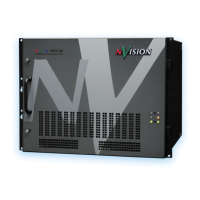NV5128 Multi-Format Router • User’s Guide 21
2. Introduction
Active Cards
Time Code Reference Connections
The NV5128 has connections for a reference source for Time Code signals labeled ‘TIME CODE’,
as shown in Figure 2-16. However, time code references are not support at this time.
Figure 2-16. Time Code Reference Connection (Rear View)
Active Cards
The NV5128 features several active cards that manage incoming signals, forward commands from
the router control system, perform signal switching, and distribute outgoing signals. Each card
slides into a card guide and has two levers that aid card insertion and ejection.
There are:
• Two control cards (one primary, one secondary; optional for redundancy).
• Up to 8 input cards.
• Up to 8 output cards.
Each input card and output card supports a specific signal type and has a corresponding backplane.
(See Signals Types and Rates
on page 5 and Backplanes on page 13.)
Card functions are described in the proceeding sections. For information on installing cards, see
Installing Active Cards
on page 44.
Control Cards
The router has two control cards (EM0374), one primary and one secondary (optional for redun-
dancy). A control card receives commands from the router control system, and in turn, controls the
input and output cards. In addition, the control card manages reference signals, supplies appropriate
timing and control signals to the input cards and output cards, and sends alarm signals to the router
control system.
Both the primary control card and the secondary control card receive router control system com-
mands, but only the primary control card actively sends commands to the output cards. Because
both cards receive router control system commands, if the active (primary) control card fails, the
back-up (secondary) control card automatically takes over processing without interruption. In addi-
tion, the primary control card and secondary control card communicate with each other. Should
either control card fail, the now active control card communicates the failure to the router control
system.
There are several jumpers on the control card which must be configured before putting the router
into service. For more information, see Control Card Jumper Settings
on page 68.
The control card receives power from the motherboard and includes a status reporting circuit. Four
LEDs on the front of the control card indicate the card’s status: low battery (Red), alarm (Red),
active (Amber), and operating normally (Green). For more information, see Indicator LEDs
on
page 76.
Time Code
Reference
Connection
TIME CODE

